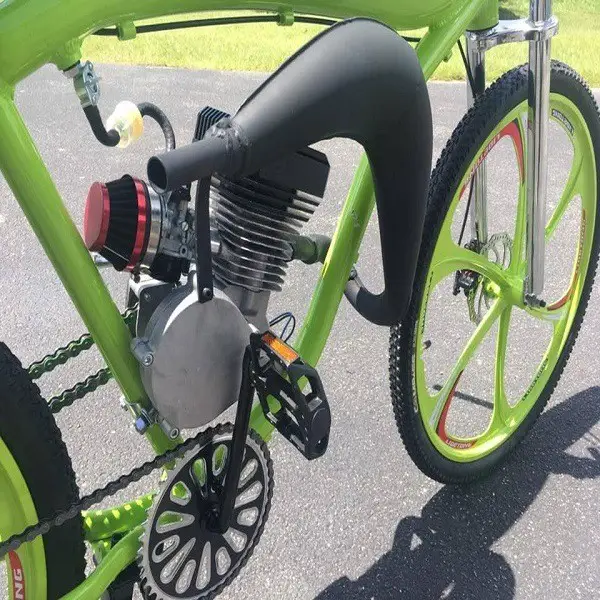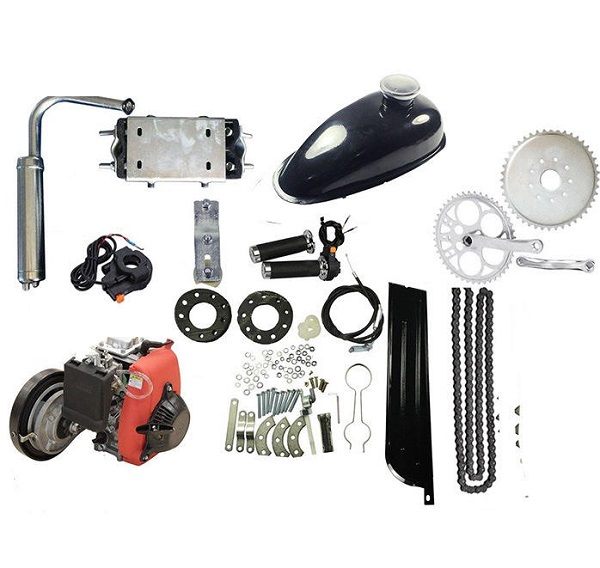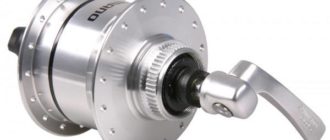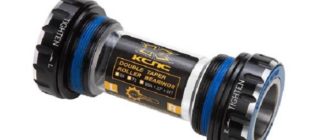The presence of an additional power source on a bicycle cannot be called a novelty. Installing a gasoline engine on the bike was the basis for the creation of mopeds and motorcycles. The conundrum arises as follows: is there a need to operate a gasoline engine for a bicycle today, when there are scooters, mopeds and other varieties of two-wheeled transport? As life practice shows, it is this element that causes much more controversy than any other part.
And there is nothing surprising here. Any other option (disc brakes, generator, headlights, horn) does not encroach on the “sacred”, that is, do not change the principle of the bike. The main mass of opponents of installing a power unit are people who use the bike to maintain physical fitness. As a rule, their bikes are lightweight designs, equipped with modern devices. They put their soul into buying equipment and improving the aerodynamic properties of the bike. Therefore, the mere thought of installing an additional power source, especially such “dirty” from an environmental point of view, seems to them blasphemy.
There is another category of cyclists who see no catastrophe in the installation of an internal combustion engine. To go for a weekend farther than usual, to overcome the mountain, sitting in the saddle, to go to the cottage on their own, not by train – all this is possible thanks to the installation of an engine. Disputes do not subside, and are unlikely to subside, so let’s sort out for ourselves the characteristics of the mechanism, its pros and cons, and at the end make appropriate conclusions.
Advantages and disadvantages
If we talk about the positive properties that the bike acquires together with the installation of the power unit, then first of all it should be noted a noticeable increase in traction and Cross-country—what-it-is–nuances ability. For example, when climbing a mountain, the cyclist will have to dismount and lead the bike in his hands, if we are talking about a simple model. But if you give the gas, it is possible to overcome the climb sitting in the saddle, that is, without straining. Other advantages:
- Increases the speed of the cyclist (up to 50 km / h).
- Increases the Cross-country—what-it-is–nuances ability.
- Low fuel consumption.
- Increased carrying capacity.
- Ability to cover large distances.
In addition, the power unit allows the cyclist to rest from time to time on the road when necessary. If the fuel runs out, the movement can continue in the usual way – by turning the pedals.
Speaking of the disadvantages of such equipment, we can highlight the main nuances:
- In the design of the bike appear additional elements (piston group, fuel tank, spark plug, belt, clutch, etc.), which increase the weight of the bike, and also make the transport more vulnerable, that is, there are mechanisms and nodes that are more prone to breakdowns.
- There is a need to carry extra cargo (fuel, spare parts and parts that may come in handy in case of breakdown).
- Increased speed. This parameter can be assessed both positively and negatively. Yes, you can move faster, then this factor increases the likelihood of accidents.
- Unclear relations with traffic police officers (we will tell about it in details a little bit later).
- Those who prefer to leisurely drive on forest and park paths, enjoying the noise of trees and birdsong, will have to listen to the loud sound of the engine.
It is impossible not to mention one major disadvantage of a gasoline-powered bicycle – the formerly environmentally friendly transport turns into a source of toxic emissions. In addition, the installation of the power unit gives the cyclist the opportunity to ride without straining at all, which is fraught with the formation of extra pounds.
Features
Structurally, a gasoline-powered bicycle is a primitive design in its own right. The difference lies only in the way in which the process of transferring torque to the wheel is carried out. Based on this parameter, there are two types.
Disc clutch
Those who remember the era of the Soviet Union, probably remember the motors of category “D” or the so-called “holes. Chinese manufacturers quickly picked up this idea and successfully established the production of similar products. The engine is attached to the frame and connected by a chain to the rear idler. Additionally, a fuel tank and other controls are installed.
The advantages of this type of motors are in the following aspects:
- reliable and convenient way of attachment;
- it is possible to start with a tow vehicle.
As for the disadvantages, here we should designate one point:
- it is necessary to install several additional units: fuel tank, clutch handle, shield, etc.
Nevertheless, such designs have found their fans and are in quite serious demand.
Centrifugal clutch
The power mechanism in this case is a monoblock, which includes a fuel tank, muffler, clutch and ratchet mechanism. At the same time, despite the abundance of additional elements, the construction is characterized by compact size and relatively low weight.
The mechanism allows you to start the movement without unnecessary manipulation – a single push is enough. Thanks to this configuration, the cyclist has only to install an additional gas handle and a toggle switch to turn off the engine.
The advantages of this design:
- minimal additional action on the part of the cyclist;
- The centrifugal clutch makes steering much easier.
There is one significant disadvantage – this motor is very loud.
Types of motors for bicycles
Power mechanisms can be divided into two groups:
- Two-stroke. The most common example is the Chinese motor F50 (an analogue of the Soviet product “D-5”, which was produced at the factory “Red October”). For mounting it is necessary to drill the frame, which is bad for its durability. Now the quality of such engines has increased markedly, the bike is easily “pulled” 40-50 km / h and “consumes” 1,5-2 liters per 100 kilometers.
- Four-stroke with a capacity of 2.5 hp.
To use it you need a fuel tank. On average, its capacity is from 0.6 to 1.5 liters. Homemade designs can hold much more. In addition, you can always take a small supply of fuel with you. Gasoline must be diluted with engine oil, the amount of which depends on the degree of running-in of the engine.
What parts are included in the powertrain installation kit
Let’s take a look at the gasoline-powered power mechanism using the Comet motorized bicycle as an example. The basic kit:
- Motor.
- Centrifugal clutch, which includes the cup, drive shaft, pads, idlers, bushings and bolts.
- Trunk (sometimes a stock one can come in handy, but it’s better to buy one from the kit).
- The throttle grip system (throttle linkage).
- Drive pulley (attaches to the rear or front wheel, depending on equipment).
- Drive pulley (transfers torque from main shaft).
- Manual engine starting system.
In addition to the above components, the kit also includes various fasteners and assembly instructions.
The best manufacturers of gasoline engines for the bike
The lion’s share of the market is Chinese products. Manufacturers from the Celestial Empire produce kits that include the following elements:
- gasoline engine;
- fuel tank;
- drive chain;
- the sprocket on the rear hub;
- clutch and throttle control knobs;
- clutch and throttle control cables;
- ignition coil;
- chain guard;
- chain tensioner.
The engine has the following features:
- volume – 48 cm3;
- average speed – 30-40 km/h;
- fuel consumption – 1 liter per 100 km;
- power – 5 horsepower.
This configuration is popular in the United States. For American consumers tuned engines up to 80 cm3 and tuned gas exhaust system were produced.
The company “Velokometa”, which is located in the northern capital of Russia, for more than 10 years has been working on various equipments of gasoline engines for bicycles. Engineers and designers have been able to successfully adapt gasoline monoblock engines into bicycle drives.
The company uses two- and four-stroke engines from well-known manufacturers (Honda and Zongshen) as the basis, adapting them for domestic users. In production, the company “Velokometa” uses the original suspension module, which allows you to install most of the typical monoblock engines. Package includes:
- outboard module;
- idler and drive pulley;
- belt with poly-V belt profile;
- idler pulley fasteners;
- drive hood;
- remote control elements.
St. Petersburg manufacturer also produces modifications with a manual clutch.
Step by step instructions for installing the engine on the bike
Equip the bike with a gasoline motor can each user – here a lot of intelligence and specific tools are not needed. But for reliability, it is better to ask for help from an experienced master.
Pay attention:
- Before proceeding to practical actions, carefully study the theoretical basics. It is necessary to clearly understand the principle of the motor and know what parts are necessary for its installation. It is necessary to determine where and how to arrange all nodes and mechanisms, so that the system works perfectly.
- Do not neglect ready-made solutions. Yes, you can collect the power mechanism literally from improvised means – so you can really save money, but it is not a fact. Today, manufacturers offer complete, proven options that allow you to install the engine on the bike without much difficulty.
Inexperienced riders should start by using centrifugal motors. This solution allows you to start riding only after the throttle is opened.
Motorcycle and traffic police – nuances
In Russia, the relationship between the traffic police and motorcyclists is still being finalized. But there are a number of nuances:
- The vehicle under discussion belongs to category “M”. If you have a driver’s license, then this category is opened by default.
- You need to have a document confirming the power of the power unit.
- It is not necessary to register, if the engine capacity does not exceed the permissible value (50 cm3). But if you are caught without a license, you will get a fine of 800 rubles. True, it is not clear how it will be issued (there are no documents) – perhaps confiscate the bike.
To avoid unnecessary questions, the bike must be equipped with reflective elements. Not superfluous will be and protective equipment of the cyclist (at least helmet).
Conclusion
Installing a gasoline engine noticeably expands the possibilities. Now you can freely ride at the weekend to the cottage or in the woods for mushrooms, not jostling in the train. But at the same time, the power unit requires the appropriate attitude and installation of additional elements.
To summarize, potential owners should pay attention to the fact that motorized bikes are designed for a quieter ride on a relatively flat surface. More often than not, the increased vibration affects:
- tires;
- rear hub of the wheel;
- screws and wrenches.
It is impossible to give an unambiguous characteristic of a motorcycle. There will be both supporters and opponents of this modification – it all depends on the purpose of the bike and the specifics of its use.











This is an interesting article to read! Gasoline bike engines are increasingly becoming popular among bikers, and it’s great to learn more about the features of the best manufacturers. It looks like gasoline bike engines offer a lot of power, affordability and convenience for riders. I’m looking forward to finding out which manufacturers come out on top!